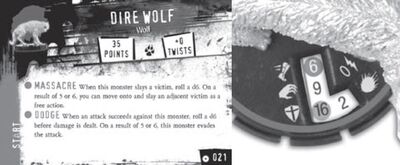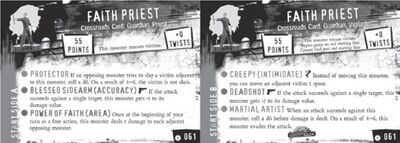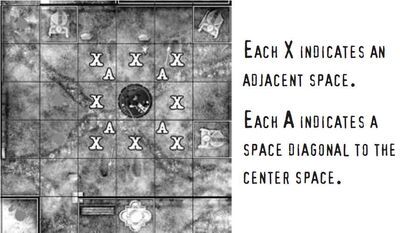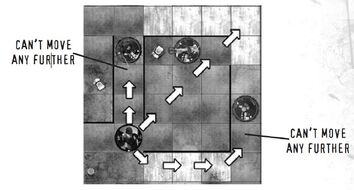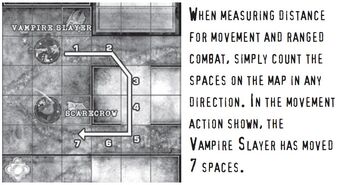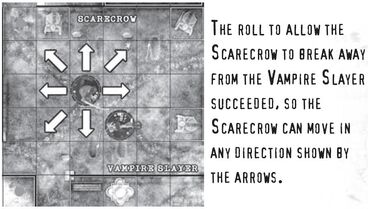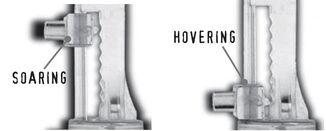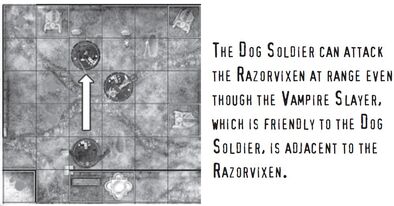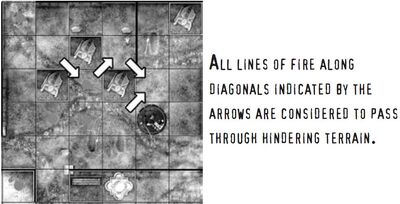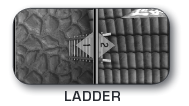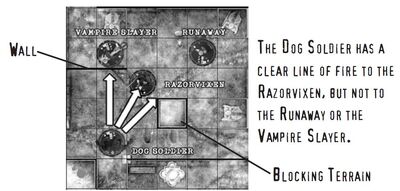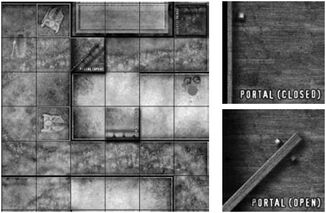Compiled from the original HorrorClix Complete Rules (ironically very incomplete), the Nightmares Rules Insert and the final Errata & Clarifications document from May 2008, and modified slightly for style and clarity.
Monstrous Anatomy[]
Monsters[]
Each miniature figure stands on a base and combat dial. The figure, base, and combat dial together are called a monster. A monster’s name is printed on its base and its monster card.
Some HorrorClix monsters look the same, but they may have different ranks, which are indicated by a colored ring on their bases. Two monsters may have wildly different combat values and powers based on their ranks. The three basic ranks are rookie (yellow ring), experienced (blue ring), and veteran (red ring). Monsters released after the Nightmares expansion do not have experience ranks, only colored tabs on their bases denoting rarity.
- Each monster’s base is printed with a set symbol that marks it as part of a particular HorrorClix set, and a collector’s number that differentiates it from other versions of the same monster.
Monster classes. Most monsters belong to at least one class. A monster’s classes (also sometimes referred to as keywords) are printed on its monster card below its name. Although there are six major classes of HorrorClix monsters (Zombies, Guardians, Occultists, Slashers, Vampires, and Werewolves), there are many other classes that a monster can belong to. Different game effects reference and/or might depend on a monster’s class.
The Combat Dial[]
The combat dial is a rotating disk found under a monster’s base. A monster’s combat dial displays a set of numbers and symbols through the L-shaped stat slot in the monster’s base. These statistics indicate how well the monster accomplishes certain tasks, or which of its powers are currently available.
Combat Values[]
Each monster has five combat values (each value appears next to its respective symbol). Four of these values are printed on the combat dial and are visible through the stat slot: speed, attack, defense, and damage. These values usually change when you turn a monster’s combat dial. The fifth value is the monster’s range value for ranged combat attacks; this value is printed on its base. Range does not change as you turn the combat dial, although it can be modified by game effects. In certain circumstances, a number on the combat dial may be replaced by a non-numeric symbol, such as an hourglass (![]() ).
).
Monster Cards & Powers[]
Each monster comes with a monster card, which details which special, supernatural, or magical abilities the monster possesses. These abilities are called powers. Note that the colored circles preceding power names on a monster card match the colored circles printed on the monster’s combat dial. A monster can use one of its powers only when the matching colored circle is visible on its combat dial.
At the beginning of the game, place each monster card so that its “Start” side is face up (the side with the solid green border). Unless the rules on the card indicate otherwise, the monster card cannot be flipped at any time.
Continuous Powers[]
Continuous powers appear only on monster cards - not dials. They are in effect for as long as the monster is in play, much like cabal powers. A continuous power has the oroboros symbol (![]() ) in front of it.
) in front of it.
Crossroads Monster Cards[]
Some monster cards have two different starting sides, each representing two entirely different play styles for that monster; these are crossroads cards. At the beginning of the game, after both players reveal their armies, both players simultaneously reveal which starting sides they will use for their monsters with crossroads monster cards. Once this choice is made, the monster must use that side for the remainder of the game.
Dependant Powers[]
Powers are in effect when they appear in the stat slot. Some powers are dependant, meaning that they activate only when the monster is given a particular action, shown below:
A dependant power is in effect only for the duration of the action that activated it. A player must declare the specific power being activated when he or she gives the monster its action. If a monster has more than one dependant power that would activate when it is given a specific kind of action, then the player must pick the one dependant power he or she wants to use.
Victim Tokens[]
Victims are the humans who, stuck in the middle of the supernatural combat, are at risk of being slain by the hordes of monsters. Victims don’t belong to any player’s force and aren’t considered to be monsters. Victims are resources to be consumed in order to make your monsters more powerful, neutralized in order to keep your opponent’s monsters from gaining certain advantages, or even protected in order to give specific kinds of monsters potent advantages.
Victim archetypes. The name of a victim is also its archetype—one of a classic kind of horror genre victim. Some common HorrorClix victim archetypes include Cheerleader, Cop, Jock, Pizza Guy, Prom Queen, and Reporter. Some game effects depend on a victim’s archetype.
Unlike a monster, which has a figure, base, and combat dial, victims are represented by flat, round victim tokens. There are only three items printed on a victim token: its speed value, its archetype, and a special symbol indicating whether the victim is male (♂) or female (♀).
- Each player should provide an equal number of victim tokens so that there are a total of 12 victim tokens being used in the game. (In a two-player game, each player brings six victim tokens; in a three-player game, each player brings four victims tokens, and so on.)
Plot Twist Cards[]
See also: Category: Plot Twists
Plot twist cards allow you to strategically affect the course of play. Most plot twists let you save a victim from being slain by an enemy monster or force a victim to run closer so that your monsters can better catch or protect them.
Crypt. Each player begins the game with six plot twist cards. This set of cards is called the crypt. A crypt may not contain more than one copy of any given card. Plot Twist cards are considered unique by expansion and card number combination.
Don’t show the cards in your crypt to your opponent until you are ready to play them; keep your crypt face down on the table.
After playing and resolving the text of a plot twist card, remove it from the game.
- Certain powerful monsters allow their owners to add additional plot twist cards to their crypts at the beginning of the game, or even allow players to use special kinds of plot twists designed specifically for certain armies.
Subplot Cards[]
A subplot card is a type of plot twist card. A player can include only one subplot card in his or her crypt per game. Subplot cards are not removed from the game after they are played, and their effects are considered active as long as their owners remain in the game. If a player who played a subplot card is eliminated from the game, however, remove his or her subplot card from the game.
Ticking Clock Cards[]
A ticking clock card is another type of plot twist card. Unlike other plot twist cards, a player can play a ticking clock card only during his or her preview phase. Also unlike other plot twist cards, a ticking clock card is not removed from the game after it is played; it stays in play unless an effect specifies otherwise.
Prepare to Play[]
Before playing a game of HorrorClix, each player builds his or her own group—or army—from his or her collection of monsters. You can build your army any way you like, even including monsters from a variety of different horror genres, such as werewolves working with vampires and ghosts fighting alongside slashers. Choose the specific monsters that will provide the capabilities you want your army to wield in battle.
An army can consist of more than one of the same monster, even if they are of the same rank. However, if a monster’s rank is Unique or Limited Edition, it is considered unique and may be included in your army only once. Note that this only applies to monsters with the exact same collector's number. Therefor the Unique and LE versions of a monster, such as Lab094 Corp. Commander and Lab202 Major Harper respectively, are considered two different monsters. You may include up to one copy of each in your army. Prior to the Nightmares expansion, Unique monsters have silver experience rings, and Limited Edition monsters have bronze experience rings. Modern Super Rare monsters are the equivalent of Uniques and have gold rarity tabs, and modern Limited Edition monsters have bronze rarity tabs. Demo monsters (designed for demonstration purposes only) have purple experience rings, and should not be used in regular play. Limited Edition Minion tokens are not considered unique unless they have a silver ring.
Point values. Each HorrorClix monster has a point value printed on its base. This is the number of points it costs to add the monster to your army.
Build total. Before playing, players should agree on the build total they will use when assembling their armies. The build total is the maximum point value allowed when the point values of all your monsters are added together. When selecting monsters for your army, you can choose monsters whose point values add up to less than or equal to the game’s build total.
- Build totals occur in multiples of 100 points: 100, 200, 300 and so on.
Step 1: Place Your Army[]
All players reveal their completed armies and lay out their monster cards face up on the table in front of them. They then place their crypts of plot twist cards face down beside the monster cards, announce how many cards they have in their crypt, and declare which monsters, if any, are providing any extra plot twist cards. Then both players simultaneously decide which sides of any crossroads cards they want to play with. Once done, each player rolls a d6. The player with the highest result is the first player (reroll ties).
Step 2: Prepare the Battlefield[]
The first player chooses the map where the battle will occur. The two-sided map included in the Starter Game gives you two choices: an indoor and an outdoor setting. After the first player chooses the map, the player to his or her left chooses the edge of the map on which he or she will set up his or her army. If there are more than two players, continue clockwise around the table until everyone has chosen a different edge and identified a starting area—the area of spaces within the purple line that runs along that edge. In two-player games, starting areas must always be on opposite edges of the map.
Step 3: Place Victims[]
The players should provide a combined total of 12 victims, with each player contributing an equal number of victims. Place these assembled victims face down on the center of the map and shuffle them; this is the victim pool. When the victims are randomized, each player (starting with the first player) takes turns placing each one (still face down) on any space printed with the ![]() symbol. Only one victim can be placed per space.
symbol. Only one victim can be placed per space.
Step 4: Place Objects (optional)[]
Starting with the first player, each player can place up to two objects on the map. Whether tombstones, portals, or other game elements, the objects must be placed on clear terrain (see “Clear terrain,” p. 31) and cannot be placed within or adjacent to a space contained within a player’s starting area. Once the first player has had the chance to place his or her objects on the map, continue in a clockwise direction until each player has had a chance to place objects.
Step 5: Prepare Monsters[]
Each player turns the combat dial of each of his or her monsters until a vertical green line appears to the left of the numbers and/or symbols visible through the stat slot. This green line indicates the monster’s starting position. (Some monster cards may direct you to start on an alternative red starting line.)
Step 6: Place Monsters[]
The first player places his or her army in his or her starting area on the map. If a player has more monsters than spaces in his or her starting area, that player can place monsters in any clear space adjacent to his or her starting area. If a player has any flying monsters in his or her army, that player must move the flight indicator on the monster’s center post to indicate if the monster is initially hovering or soaring. Then the player to the first player’s left places all his or her monsters, and so on clockwise around the table.
Step 7: Reveal Subplot Cards[]
All players who included a subplot card in their crypts reveal those cards simultaneously and place them face up on the table.
Once steps 1–7 are complete, the first player takes the first turn.
Important Game Concepts[]
Players should familiarize themselves with the following game concepts before playing their first game. Players will also find the glossary to be a useful reference as they read through these rules.
Active Player[]
The player currently taking a turn is the active player.
Actions[]
On his or her turn, each player gets one action for every 100 points of the game’s build total; this number of actions does not change throughout the game. A player need not use all of his or her actions, but any unused actions are not carried over.
Action Tokens[]
Action tokens are used to remind all players that a monster has been given an action during the current turn. If you assign an action to a monster, place the action token next to the monster on the map once the action resolves. You can use any small object, such as a coin or bead, as an action token.
At the end of your turn, if any monster you control was not given an action that turn, clear all action tokens from that monster. Monsters with two action tokens cannot be given actions (other than a free action) until both action tokens are cleared.
Vulnerability[]
When a monster has two action tokens, it is vulnerable. Vulnerable monsters are susceptible to certain kinds of powers and attacks, as indicated by those powers and attacks.
Free Actions[]
Some game effects and powers require a free action to activate them, or allow a monster to do something as a free action after completing another kind of action. Monsters do not receive action tokens for taking a free action. The free action does not count as one of your available actions for the turn.
Adjacent Spaces[]
Adjacent spaces are spaces that touch each other on the map, including spaces on the diagonal. Monsters and victims occupying adjacent spaces are adjacent to one another. Monsters and victims on opposite sides of walls are not adjacent.
Friendly and Opposing Monsters[]
Friendly monsters are monsters controlled by you. Opposing monsters are monsters controlled by an opponent. Friendly and opposing status can change during the course of the game (for example, during insanity and possession). Unless specifically noted, victims are not friendly to any player.
Hourglasses[]
A monster with an hourglass showing in place of particular combat value is subject to certain restrictions or circumstances. Though monsters usually enter an hourglass state as result of taking damage, some monsters start the game in an hourglass state.
 Immovable: A monster showing an hourglass symbol in place of its speed value cannot be assigned move actions. In addition, monsters do not need to roll to break away from this monster.
Immovable: A monster showing an hourglass symbol in place of its speed value cannot be assigned move actions. In addition, monsters do not need to roll to break away from this monster. Incapable: A monster showing an hourglass symbol in place of its attack value cannot be assigned any attack actions
Incapable: A monster showing an hourglass symbol in place of its attack value cannot be assigned any attack actions Intangible: A monster showing an hourglass symbol in place of its defense value cannot be targeted by any attack, and it does not block line of fire. An Intangible monster may still take damage.
Intangible: A monster showing an hourglass symbol in place of its defense value cannot be targeted by any attack, and it does not block line of fire. An Intangible monster may still take damage.
At the end of the active player’s turn, he or she must deal 1 unpreventable damage to every monster in the hourglass state that he or she controls.
Rounding[]
Sometimes a game effect will tell you to reduce a monster’s combat value by half. If this would result in a fraction, round up.
Replacement Values and Modifiers[]
Some game effects, including some abilities, allow the substitution of one combat value for another. These substitute values are called replacement values. For example, when one value “becomes” or is used “instead of” another value, it is a replacement value. When a monster’s combat value is reduced by half, that is also a replacement value.
Modifiers increase or reduce a combat value by a specific amount. A modifier cannot reduce a combat value to less than 0. Replacement values are not modifiers.
Modifiers and replacement values that take effect during an action are in effect only for the duration of that action, unless stated otherwise. Modifiers and replacement values that take effect during an attack are in effect only for the duration of that attack, unless stated otherwise.
If a modifier and a replacement value would both affect a combat value, apply the replacement value, and then the modifier.
Rule of 3[]
The rule of 3 places a limit on how much a combat value can be modified. The rule of 3 states that no combat value can be modified by more than 3. For example, if the combat value is 3, it cannot be increased to more than 6 or reduced to less than 0. Although the effects of powers and plot twist cards supercede these HorrorClix rules when they conflict, the rule of 3 always takes precedence. Replacement values are not subject to the rule of 3. (A value can be replaced by a number that is more than 3 greater than itself, but if the replaced value is subsequently modified, it cannot be modified by more than 3.)
Transforming[]
When some monsters achieve certain objectives indicated on their monster cards (such as killing a certain number of monsters or slaying a certain number of victims), they transform into more powerful forms. When a monster transforms, flip its monster card; play continues with the player using the powers printed on the side of the card that is newly face up.
A transformation might indicate to turn the monster’s dial to its alternative starting line; ignore any skulls you see as you click through the dial.
In Play[]
Game elements such as monsters, victim tokens, objects, and plot twist cards that have been legally played on the table are considered to be in play. A game element must be in play (in the game) to have an effect on the game. Face-down plot twist cards in a player’s crypt are not considered to be in play until their owner decides to play them. Slain and rescued victim tokens that have been placed on monster cards are still in play.
When a monster is killed, it is removed from the game along with its monster card and any victim tokens placed on it. An object that has been smashed or eliminated is removed from the game. When a plot twist card is played and its effect resolves, it is removed from the game. Ticking clock cards are removed from the game when replaced by other ticking clock cards.
A game element that has been removed from the game cannot be used again in the current game and is returned to its owner.
Cabals[]
Some monsters belong to groups called cabals. Each cabal has a leader that possesses a power—called a cabal power—that all friendly members of that cabal can benefit from or contribute to.
If you choose to include a cabal leader in your army, then all the monsters you control that share the leader’s cabal symbol can be affected by or use its cabal power, per the power’s description. If the cabal leader leaves play, the cabal power cannot be used. Likewise, if the cabal leader is affected by a special mental state, such as insanity or possession, the cabal power cannot be used while the condition persists.
Turns[]
The HorrorClix game is played in a series of turns. The first player takes the first turn, and may take a number of actions depending on the build total for the game. When the first player’s turn is complete, the player to the left takes the next turn, and so on, clockwise around the table. If all of a player’s monsters are eliminated from the game, then that player is out of the game, and the remaining players continue taking turns in the same order until only one player remains.
Phases. Turns are divided into four phases, which are completed in order:
- Preview Phase
- Suspense Phase
- Hunting Phase
- Hourglass Phase
The Preview Phase[]
- Game effects that last until the beginning of your turn end.
- Resolve any game effects that occur at the beginning of your turn, or play any ticking clock plot twist cards. Effects or plot twists that occur “at the beginning of your turn” can be performed in any order, as chosen by the active player. Any monster card which states “At the beginning of your turn you can flip this card,” may only be flipped once per turn.
The Suspense Phase[]
During the suspense phase, the active player may choose to move one victim. Some powers will allow a player to move more than one victim. If the player does not choose to move a victim, then the suspense phase ends and the hunting phase begins.
- The active player chooses a victim to move. This victim becomes the chosen victim. If the chosen victim is face down, flip it face up.
- In response, the opponent to the active player’s left may choose to play one plot twist card that affects the chosen victim. If the opponent declines to play a plot twist, the active player may play one plot twist card that affects the chosen victim.”
- If a plot twist card is played, follow the instructions on the card.
- If no plot twist card is played, the active player moves the victim.
Moving Victims[]
A victim can be moved a number of spaces up to its speed value. It can move through spaces adjacent to other monsters or other victims, but it cannot move through spaces
occupied by a monster or another victim.
The Hunting Phase[]
During your turn, you give actions to your monsters. You cannot give more than one action per turn to any monster you control, and you can resolve only one action at a time. There are three kinds of actions you can give to a monster:
- Move Action

- Close combat action (vs. an adjacent monster)

- Ranged combat action (vs. a nonadjacent monster)

Moving Monsters[]
Each monster has a symbol printed on its base next to its speed value that describes how it moves; this is its speed mode.
A ![]() speed symbol indicates that a monster is affected by terrain, such as water
speed symbol indicates that a monster is affected by terrain, such as water
terrain or hindering terrain, per the rules for that terrain (see “Terrain,”)
A ![]() speed symbol or
speed symbol or ![]() speed symbol indicates that a monster interacts with the map in other special ways (see below).
speed symbol indicates that a monster interacts with the map in other special ways (see below).
A monster given a move action can move up to its speed value in spaces across the map. A monster can move diagonally, as shown below. A monster does not have to move its full speed value; it can move 0 spaces.
A monster’s movement ends if it enters a space adjacent to an opposing monster. If a monster moves adjacent to a face-down victim at any point during its movement, that victim is turned face up.
A monster can move through a space occupied by a friendly monster, but it cannot move through a space occupied by an opposing monster or a victim. If a monster moves or is moved in such a way that it will end its movement in the same space as another monster, the monster must end its movement before entering the occupied space.
Breaking Away[]
If a monster occupying a space adjacent to one or more opposing monsters is given a move action, combat action, or free action that would result in movement, that monster must attempt to break away, as shown in the diagram below. Roll a d6. On a result of 1–3, the monster fails to break away and cannot move. The move action is over, and the player gives the monster an action token.
On a result of 4–6, that monster has broken away from all adjacent opposing monsters and can move. Only one successful break away roll is required to move away from all adjacent opposing monsters. The monster can move through spaces adjacent to every opposing monster from which it broke away; however, if the monster enters a space adjacent to an opposing monster to which it was not adjacent when it broke away, the monster must end its movement.
Flying Monsters[]
Flying monsters have the ![]() speed symbol, as well as flight stands. Flying monsters use all the standard rules for monsters, except where noted. Flying monsters have two different flight modes—hovering and soaring—which are indicated by moving the flight indicator on the monster’s flight stand down for hovering and up for soaring.
speed symbol, as well as flight stands. Flying monsters use all the standard rules for monsters, except where noted. Flying monsters have two different flight modes—hovering and soaring—which are indicated by moving the flight indicator on the monster’s flight stand down for hovering and up for soaring.
- Monsters that are not soaring are called grounded monsters.
Flying monsters can move through spaces adjacent to and occupied by opposing monsters without having to stop. A flying monster occupies its space, regardless of flight mode. Victims and other monsters cannot occupy the same space as a flying monster.
Elevation Change Modifier. A flying monster can change flight modes when moving. Modify the speed value of a flying monster by –1 each time it ascends to soaring level or descends to hovering level; this is the elevation change modifier.
Flight Mode: Hovering[]
A hovering monster floats near the ground. To show that a monster is hovering, move the flight indicator on its flight stand to its lowest position. A hovering monster ignores the effects of hindering terrain on movement. Hovering monsters can move over outdoor blocking terrain without changing flight modes.
- Hovering is the only flight mode monsters can use indoors.
Flight Mode: Soaring[]
A soaring monster is flying high in the air. To show that a monster is soaring, move the flight indicator on its flight stand to its highest position. Soaring monsters ignore the effects of all types of terrain and objects for movement purposes.
Swimming Monsters[]
A monster with the ![]() speed symbol can swim. Swimming monsters use all the standard rules for monsters, except that they treat water terrain as clear terrain for movement purposes.
speed symbol can swim. Swimming monsters use all the standard rules for monsters, except that they treat water terrain as clear terrain for movement purposes.
Slaying Victims[]
In order for a monster to slay a victim, give it a move action and end its movement in a space occupied by the victim. The victim is slain and placed on the monster card of the monster that slayed it.
- Depending on player preference, slain victims may be stacked beneath the monster’s base rather than on the monster card.
When a player’s monster is about to slay a victim, the opposing player to that player's left may choose to play a plot twist card or monster power that specifically affects the slaying of a victim. If the opponent declines to play a plot twist, the active player may play one plot twist card that specifically affects the slaying of a victim. If playing such a plot twist card or using a monster power prevents the slaying attempt, then the opponent to the active player’s left places the victim in an adjacent unoccupied space. In the event that there is no adjacent unoccupied space in which to place the victim, such as if it’s cornered at the end of a long hallway, then nothing can prevent the slaying.
A monster may slay victims while soaring.
A monster that has a victim token on it's card is blooded. A blooded monster can frenzy (see “Frenzy").
Rescuing Victims[]
Monsters that are more benevolent (or have hidden agendas) can rescue victims instead of slaying them. The process of rescuing a victim is identical to slaying a victim, though plot twist cards and powers that prevent the slaying of victims cannot be used to prevent a victim from being rescued, and vice versa.
Combat Actions[]
You can give a monster two kinds of combat actions: close combat actions and ranged combat actions. The monster given the action and making the attack is called the attacker. The monster against which the attack is made is called the target.
You cannot target a friendly monster with an attack unless a power specifically says otherwise. Additionally, a monster cannot target itself with an attack. You cannot target a victim with an attack.
The following general rules apply to both close combat and ranged combat attacks.
The Attack Roll[]
To determine the success or failure of an attack, the attacking player makes an attack roll. Roll 2d6 and add the result to the attacker’s attack value. If the result is equal to or greater than the target’s defense value, the attack succeeds.
Damage[]
When a monster succeeds at an attack, the damage dealt is equal to its damage value, modified by any powers. The target takes that much damage, modified by any of its own powers. Your opponent turns the target’s combat dial clockwise a number of times equal to the damage taken.
- The only time a monster’s dial should be turned during a game is when it is
damaged, it is healed of damage, or the rules specifically indicate to do so.
No Damage. An attack that deals no damage cannot have the damage modified. Attacks that deal no damage deal neither critical hit damage to the target nor critical miss damage to the attacker (see “Critical Misses and Critical Hits")
0 damage. A power that deals 0 damage can have the damage modified. It follows the rules for critical hit and critical miss damage. If the damage is not modified, 0 damage is dealt.
Unpreventable damage. Unpreventable damage cannot be reduced or dealt or transferred to another monster.
Healing damage. Certain powers and/or circumstances can heal monsters of damage. When healing a monster, click its combat dial counterclockwise a number of times equal to the damage healed.
- No monster can heal past its starting line unless its monster card specifically allows it.
Killing Monsters[]
If a monster’s dial ever shows three skull symbols, the monster is killed and must be removed from the game.
Critical Misses and Critical Hits[]
If you roll two 1s on an attack roll, the attack fails, even if the attack roll result would be high enough to succeed. This is called a critical miss. Immediately deal 1 unpreventable damage to the attacker.
If you roll two 6s on an attack roll, the attack succeeds, even if the attack roll result wasn’t high enough to succeed. This is called a critical hit. The critical hit increases
damage dealt by 1 for the attack. If your attack is against multiple ranged attack targets, this extra damage affects all successfully hit targets.
Close Combat[]
Close combat represents hand-to-hand combat and melee weapon attacks.
Your monster must be adjacent to a target in order to make a close combat attack against it.
Frenzy[]
When a blooded monster frenzies, it gets two actions for the price of one. Give your blooded monster a move action. When the move action has resolved, the monster can be assigned a close combat action as a free action. At that time you may choose to activate one (and only one) of your monster’s powers marked with the close combat ‘cleaver’ symbol. Frenzy must be declared at the beginning of the move action, before any breakaway rolls if applicable. The close combat action granted during frenzy is optional, and there is no need to declare a target when declaring frenzy. If a monster that has declared frenzy is no longer blooded after the resolution of the move action, then it may not be assigned a close combat action.
When a monster frenzies, its damage value becomes 1, but it can be modified or replaced.
At the end of the frenzy (the action), the monster is given only one action token.
- If a monster is frenzying and fails a break away roll, its controller may still choose to make its free close combat attack against an adjacent opposing monster.
Example: A monster with a damage value of 4 frenzies; its damage value becomes 1 for the duration of the frenzy. If, however, the monster has a power that modifies or replaces its damage, like Slash (If the attack succeeds, roll a d6 before dealing damage: Replace this monster’s damage value with the result.), the monster would deal a d6 of damage instead of only 1 damage.
- A blooded monster can frenzy in such a manner that it moves, slays a victim at the end of its movement, and makes a close combat attack against an adjacent opposing monster.
Ranged Combat[]
Ranged combat represents attacks from a distance, such as hurled knives, shotgun blasts, psychic firestorms, and mind-control assaults.
If a monster is adjacent to an opposing monster that is at the same elevation (grounded/hovering next to grounded/hovering, or soaring next to soaring), it cannot make a ranged combat attack, regardless of its speed mode.
Range Value[]
A monster’s range value is the maximum number of spaces that its ranged attack can reach. If the range value is greater than 0 and your monster is not adjacent to an opposing monster, then it can make a ranged combat attack against an opposing monster. A monster can attack in any direction, regardless of the direction it is facing.
Monsters cannot make ranged combat attacks against victims unless a power specifically states that they can.
Line of Fire[]
Before making a ranged combat attack, the target must be within range, and you must determine if the attacker has a clear line of fire to the target. You are allowed to check the map to see which targets are valid targets. To determine if there is a clear line of fire, use any straight edge or draw an imaginary line from the center of the attacker’s space to the center of the target’s space. If the imaginary line passes through a space occupied by a monster (other than the attacker and target) or victim, or if it crosses blocking terrain (such as a wall), the line of fire is blocked and the monster cannot make the attack.
A line of fire that passes between two adjacent monsters, even on an exact diagonal, is blocked. Soaring monsters block line of fire only if the line is being drawn to or from another soaring monster. Grounded or hovering monsters block line of fire only between other grounded or hovering monsters. If an attacker has a clear line of fire, count the shortest route to the target in spaces using the imaginary line as a guide. Do not count the space the attacker occupies when determining range.
Indoor/outdoor line of fire. Some maps have notations denoting indoor terrain (the inside of houses, crypts, sanitariums) and outdoor terrain (graveyards, campgrounds, and ritual sites). Grounded or hovering monsters that are indoors cannot be targeted by ranged combat attacks from soaring monsters, and vice versa.
Multiple Ranged Combat Targets[]
All monsters have at least ![]() one symbol printed next to their range values. The number of lightning bolts indicates the number of different targets the monster can target with a single ranged combat attack. A monster cannot target the same monster more than once with any one ranged combat action. If a monster attacks more than one target, it must be able to draw a clear line of fire to each target. A monster can use its full range value against each target. A monster may choose to target fewer monsters than it has lightning bolts.
one symbol printed next to their range values. The number of lightning bolts indicates the number of different targets the monster can target with a single ranged combat attack. A monster cannot target the same monster more than once with any one ranged combat action. If a monster attacks more than one target, it must be able to draw a clear line of fire to each target. A monster can use its full range value against each target. A monster may choose to target fewer monsters than it has lightning bolts.
When your monster targets more than one monster with a ranged combat attack, make only one attack roll; compare the attack roll result to each target’s defense value. Some targets with low defense values might be affected, while others with high defense values might not be affected.
Dealing Damage to Multiple Ranged Targets[]
When your monster succeeds at a ranged combat attack against multiple targets, divide its damage any way you choose among the successfully hit targets. A successfully hit target may be dealt 0 points of damage or any nonfractional amount of damage, provided that damage dealt is divided among the successfully hit targets.
Hovering Monsters and Combat[]
Hovering monsters can make close combat attacks only against adjacent opposing grounded monsters.
Soaring Monsters and Combat[]
Soaring monsters can make close combat attacks only against adjacent soaring monsters, and ranged combat attacks against grounded and soaring monsters. Grounded monsters may make only ranged combat attacks against soaring monsters. Ignore blocking terrain, grounded monsters, and victims when drawing line of fire to orfrom a soaring monster.
Combat between grounded and soaring monsters. Modify a grounded monster’s attack value by +2 when it makes a ranged combat attack against a soaring monster. If the attack succeeds, and the soaring monster takes at least 1 damage from the attack, the attack also deals 1 additional unpreventable damage. Move the flight indicator of such a target to hovering mode.
The Hourglass Phase[]
Once you have resolved all of your actions for your turn and placed the appropriate action tokens, before the next player’s turn don’t forget to
- remove action tokens from monsters you control that weren’t assigned actions this turn; and
- deal 1 unpreventable damage to any monster you control that is in the hourglass state.
Terrain[]
Terrain can be the natural landscape of the battlefield, walls or other objects depicted on the map, object tokens and 3-D objects placed on the map at the beginning of the game, or they can be effects created by the use of powers.
HorrorClix has four types of terrain: hindering, water, elevated and blocking. All types of terrain are indicated by boundary lines drawn on the map:
- Spaces inside the boundary of a green line are hindering terrain.
- Spaces inside the boundary of a blue line are water terrain.
- Spaces inside the boundary of a red line are elevated terrain.
- Spaces inside the boundary of a brown line are blocking terrain.
Clear Terrain[]
Clear “terrain” is open space with no obstructions or other features, such as a park, soccer field, or an empty street. Monsters and victims can move through spaces of clear terrain without penalty. If a space does not fall inside the boundary of a colored line, it is clear terrain. (Shaded spaces inside the boundary of a brown line are indoor spaces on an indoor/outdoor map; these spaces are clear terrain unless indicated otherwise.)
If a space has a colored boundary line inside it, the space is the type of terrain indicated by the line. If a line can be drawn from the center of a space into a second space without crossing a boundary line, that second space is the same type of terrain as the first space.
All nonclear terrain is surrounded by a continuous boundary. If a game effect allows for the alteration of terrain, boundary lines are assumed to change so that they always form an uninterrupted boundary.
Hindering Terrain[]
Hindering terrain is an area containing trees, fog, debris, or other similar items or phenomena that might obstruct a monster’s actions.
A monster or victim that crosses a boundary line into a space of hindering terrain from any other type of terrain must stop moving. Diagonally adjacent spaces that contain hindering terrain are considered continuous hindering terrain. When a monster or victim moves from nonhindering terrain through the corner between two diagonally adjacent spaces of hindering terrain, the continuous hindering terrain causes the monster’s or victim’s movement to end in the space after crossing the corner.
The speed value of a monster or victim that begins its movement in hindering terrain is halved before moving.
Monsters ignore hindering terrain for close combat purposes.
Hindering Terrain and Ranged Combat[]
If a line of fire between two monsters crosses the boundary line of hindering terrain, modify the target’s defense value by +1 for the attack; this is called the hindering terrain modifier. If the line of fire between two characters in continuous hindering terrain never crosses a boundary line of hindering terrain, the hindering terrain modifier still applies. Add this modifier only once, regardless of the number of spaces of hindering terrain the line of fire passes through.
If the attacker occupies a space of hindering terrain and the line of fire crosses the boundary line for that hindering terrain without crossing another space of hindering terrain, the hindering terrain modifier does not apply. This represents an attacker’s ability to fire from the edge of hindering terrain—protected by it, but not impaired by it.
A line of fire is considered to pass through hindering terrain if it passes through the diagonal of two diagonally adjacent hindering terrain spaces and any of the following: blocking terrain, a monster, a victim, or another piece of hindering terrain.
Water Terrain[]
Spaces inside the boundary of a blue line are water terrain, such as streams, ponds, and other liquids. Water terrain is hindering terrain for movement purposes and clear terrain for line of fire purposes.
Elevated Terrain[]
With the transition to HorrorClix 1.5 comes the inclusion of Elevated Terrain from HeroClix. Elevated terrain represents space above the ground level of the battlefield, such as cliffs and rooftops. Some elevated terrain is marked with a number representing its level of elevation. Maps without these numbers treat non-elevated terrain as Level 1 and elevated squares as Level 2.
Elevated terrain can contain other types of terrain; these squares are considered to have the properties of both terrain types. Anything occupying elevated terrain is considered to be at that elevation level. Anything not elevated is considered grounded or at elevation level 1. Monsters at different elevations are not considered adjacent for any game effect. A monster at a lower elevation is adjacent to elevated terrain when the only reason the square in question is not adjacent is because it is a higher elevation.
To enter or leave Elevated terrain, a monster must use stairs and ladders. On maps where elevation levels are marked, the spaces containing those markers are considered stairs or ladders. A monster cannot "jump off" elevated terrain to a lower elevation unless it has a power or ability allowing it to do so. Part of a stairway or ladder is on terrain of a lower elevation and part is on terrain of a higher elevation. A monster must pass through the two squares of different elevation to change the monster’s elevation.
Characters occupying these two squares can make close combat attacks against eachother as though they were adjacent. Stairs and ladders are clear terrain, unless there are map boundary lines indicating otherwise.
Line of Fire[]
If a line of fire between two squares on the same elevation crosses elevated terrain of a higher level, it is blocked. The line of fire between squares on the same elevation is not blocked by elevated terrain of that level or lower, though other terrain at that elevation level crossing the line of fire affects it normally.
A square with a red line running through it with an elevation of a lower level sharing an edge with it is considered “the rim.” Monsters on the lower elevation are not adjacent to the rim any more than they are adjacent to a character occupying the square that the rim borders. A line of fire between monsters or squares on different elevations is blocked by:
- Blocking terrain on the same elevation as the square on the lower elevation.
- Elevated terrain of any level higher than the level of the square on the lower elevation, except the square of higher elevation the line of fire is being drawn to or from.
- Monsters using the Great Size ability.
A line of fire between monsters or squares on different elevations is not affected by ![]() monsters or hindering terrain, except for the square the target occupies.
monsters or hindering terrain, except for the square the target occupies.
Blocking Terrain[]
Blocking terrain is an area on the battlefield with the potential to completely impede actions.
Monsters and victims cannot move into or through blocking terrain. No monster or victim can occupy a space of blocking terrain. Blocking terrain blocks any line of fire that crosses into the boundary line surrounding it. Blocking terrain spaces that are diagonally adjacent are considered continuous blocking terrain, and they block any movement through the diagonal between them.
A line of fire that passes through the diagonal of two diagonally adjacent blocking terrain spaces is blocked by the blocking terrain. A line of fire that passes through the diagonal between a space of blocking terrain and a space containing a monster or victim is blocked.
Walls[]
Walls are a special type of blocking terrain indicated by heavy black lines that run along the grid lines marked on the map. Walls have no boundary lines, but they do have all the effects of blocking terrain. Monsters on opposite sides of walls are not adjacent, cannot target each other with close combat attacks, and do not need to roll to break away from one another. All walls are assumed to stop exactly at the edges of squares. Even if it looks like a wall “sticks out” into a doorway, it doesn’t, and thus diagonal attacks can pass through without being blocked.
Objects[]
The HorrorClix Starter Game comes with a number of two- and three-dimensional objects to be used with your games, such as portals, tombstones, and trees. Once placed on the map at the beginning of the game, these pieces cannot be moved.
Portals[]
Portals are a special type of blocking terrain. Portals are represented by cardboard markers that indicate doors, gates, or other barriers. Portals have two sides, one showing an open doorway and one showing a closed doorway. When placing a portal during setup, you can place it only in clear terrain, with its “open” side facing up.
The edge of the portal that shows the doorway is what counts as blocking terrain when the door is closed. A portal is open when no monsters or victims occupy the spaces on either side of its doorway. A portal is closed when at least one monster or victim occupies a side of the doorway. Flip the portal over as appropriate during the game as its doorway opens or closes.
Open portals. When a portal is open, monsters and victims can move across its space freely, and monsters can draw clear lines of fire through it as if the entire space were clear terrain.
Closed portals. When a portal is closed, its doorway edge acts as blocking terrain when determining line of fire. When moving a monster, if there are no opposing monsters or victims in the two spaces on either side of the doorway, then you can move your monster through the doorway as if it were open. If there is an opposing monster or victim on either side of the portal, then the portal is considered to be closed, the doorway edge counts as blocking terrain, and you cannot move your monster through the doorway. When moving a victim, follow the same rules with the exception that other victims do not cause portals to be considered closed.
Smashing portals. A monster in one of the two spaces on either side of a portal’s doorway can attempt to smash the portal with a close combat attack. Make an attack roll; if the attack roll result is at least 13, the portal is smashed and should be removed from the game.
Tombstones[]
If a target of a ranged combat attack is adjacent to a tombstone, the tombstone acts as a space of blocking terrain when determining line of fire. No monster or victim can end its movement on a space occupied by a tombstone, but it can move through a space occupied by a tombstone as if it were clear terrain. Tombstones can be placed only on outdoor sections of maps.
Smashing tombstones. After being assigned a close combat action, a monster adjacent to a tombstone can attempt to smash it. Make an attack roll; if the attack roll result is at least 13, the tombstone is smashed and should be removed from the game.
Tree of the Damned[]
If a victim is slain while adjacent to a Tree of the Damned, the active player gets one extra action to use that turn. A single Tree of the Damned may not provide more than one extra action per turn, and a victim may not trigger more than one Tree of the Damned.
If a target of a ranged combat attack is adjacent to a Tree of the Damned, the Tree of the Damned acts as a space of blocking terrain when determining the line of fire. No monster or victim can end its movement on a space occupied by a Tree of the Damned, but it can move through a space occupied by a Tree of the Damned as if it were clear terrain.
A Tree of the Damned can be placed only on outdoor sections of maps.
Maps[]
HorrorClix has three kinds of maps: outdoor, indoor, and indoor/outdoor maps. The Crumbling Mausoleum map is outdoor. The Haunted House map is indoor.
Outdoor Maps[]
Outdoor maps have no interior spaces. A map labeled “outdoor” or “outdoors” is an outdoor map. Terrain on an outdoor map is called “outdoor terrain.” All standard rules apply to a battle on an outdoor map.
Indoor Maps[]
Indoor maps depict battlefields located entirely inside a building or structure. A map labeled “indoor” or “indoors” is an indoor map. Terrain on an indoor map is called “indoor terrain.” Battles on an indoor map use all the standard rules, with the following exceptions:
Indoor/Outdoor Maps[]
Maps labeled “indoor/outdoor” have portions that follow the rules of both indoor maps and outdoor maps. Indoor/outdoor maps follow all the rules of outdoor maps, except that spaces inside the boundary of a yellow line follow all the rules of indoor maps.
Other Important Rules[]
Minions[]
Some monsters have the power to turn victims into their servants, such as a vampire making a human into a thrall, or a grad student being turned into a werewolf after being bitten by one. When a monster’s power indicates that it creates a minion when it slays a victim, remove the victim from the game and replace it with an appropriate minion token.
A minion is treated like a monster except that it cannot be blooded and it can take only 1 damage before it is killed and removed from the game. Minions belong to the class in their name. For example, a Werewolf Minion belongs to the werewolf class. Minions are not worth victory points unless a subplot, plot twist, or other game effect specifically states otherwise.
Victims used to create minions, as well as victims slain or rescued by minions, are placed on the cards which allow those minions to be created. These cards are treated as monster cards for purposes of “Determining Victory” in Section 10 of the rulebook.
Insanity[]
At the beginning of a player’s turn, if the Insanity power is showing on the dial of a monster that he or she owns and controls, the result of a d6 die roll must equal or exceed the indicated number. If the die roll result succeeds, then nothing happens. But if it fails, the monster becomes insane.
When a monster goes insane, the monster’s owner cannot assign it actions that turn; clear the monster of all action tokens. When the owner’s turn ends, the next active player controls the insane monster, and action tokens are assigned normally. For each player in sequence, the insane monster is friendly to the active player and opposing to all other players. This continues for each active player until the beginning of the owner’s next turn, at which time he or she regains control of the monster. But if the monster’s dial is still showing the Insanity power, then the owner must roll once again to see if the monster goes insane. (Only the monster’s owner can make an insanity roll for it.) An insane monster is worth no victory points (see “Determining Victory”) when killed. A monster killed by an insane monster earns the active player victory points.
If the transfer of control of a monster due to Insanity causes one player to control all the monsters on the map,
then the game ends per the rules of Section 10: Ending the Game.
Possession[]
Certain monsters have the power to gain control of opposing monsters for a short period of time (as described in those powers). When a monster is possessed, it becomes a puppet friendly to the active player until the end of his or her turn. The active player can assign actions to the puppet, and action tokens are assigned normally. If a monster with 2 action tokens is Possessed, it may still be given an action.
During the hourglass phase, after all monsters you control in the hourglass state have been dealt 1 unpreventable damage, deal 1 unpreventable damage to any puppet you control, and assign it action tokens so that it becomes vulnerable (if it wasn’t already vulnerable). A possessed monster is worth no victory points when killed. A monster killed by a possessed monster earns the active player victory points.
If the transfer of control of a monster due to Possession causes one player to control all the monsters on the
map, then the game ends per the rules of Section 10: Ending the Game.
Giants[]
A monster with the ![]() damage symbol is a giant monster. Giant monsters loom over the battlefield, and they have a much longer reach than other monsters do.
damage symbol is a giant monster. Giant monsters loom over the battlefield, and they have a much longer reach than other monsters do.
A giant monster is adjacent to standard monsters (those which occupy only 1 space and do not have the ![]() damage symbol) and other giant monsters when those monsters are up to 2 spaces away for close combat purposes, regardless of the other monster's flight mode. A standard monster must be within 1 space of a giant monster to make a close combat attack against it. Monsters 2 spaces away from a giant monster are not considered adjacent for ranged combat purposes.
damage symbol) and other giant monsters when those monsters are up to 2 spaces away for close combat purposes, regardless of the other monster's flight mode. A standard monster must be within 1 space of a giant monster to make a close combat attack against it. Monsters 2 spaces away from a giant monster are not considered adjacent for ranged combat purposes.
To determine if a monster 2 spaces away is adjacent to a giant monster, use any straight edge or draw an imaginary line from the center of the giant monster's space to the center of the target's space. If the line crosses a wall or blocking terrain, the monsters are not adjacent. Otherwise, they are adjacent.
Giant monsters ignore hindering terrain, outdoor blocking terrain and standard monsters for movement purposes, though they must still end their movement on an unoccupied space and must roll to break away when applicable. Giant monsters ignore other monsters' Shove and Trap powers.
Standard monsters do not block line of fire to or from a giant monster. Hindering terrain and blocking terrain affect line of fire to a giant monster as normal. A giant monster and a soaring monster draw lines of fire and attack each other as if they were both soaring. All giant monsters have the following power:
Carry ![]() - If there is a friendly standard monster adjacent to this monster, when this monster ends its movement, you can place that monster in an unoccupied space adjacent to this monster. If you do, mark this monster with action tokens so that it becomes vulnerable.
- If there is a friendly standard monster adjacent to this monster, when this monster ends its movement, you can place that monster in an unoccupied space adjacent to this monster. If you do, mark this monster with action tokens so that it becomes vulnerable.
Double-Base Monsters[]
A double-base monster is mounted on a base with two ends that each occupy 1 space (for a total of 2 spaces). A double-base monster has 10 adjacent spaces when not on a diagonal. When occupying diagonally adjacent spaces, double-base monsters have 12 adjacent spaces, blocks line of fire across its diagonal, and monsters on opposite sides of its diagonal are not adjacent.
Moving[]
The player moving a double-base monster chooses any space adjacent to the double-base to begin counting movement. A double-base monster must end its movement so that both ends of its base occupy spaces within its speed value. When a double-base monster stops its movement on a diagonal, it occupies only the 2 spaces occupied by the center dots printed on its base. A double-base monster can't end its movement with a wall between the center dots printed on its base.
A double-base monster can attempt to slay two victims if it is given a move action and ends its movement so that each end of its base occupies a space also occupied by a victim. When a dobule-base monster attempts to slay two victims this way, an opposing player can play a plot twist card for each victim that would be slain; the opposing player chooses when victim he or she is playing a plot twist card for. The active player chooses which slaying attempt to resolve first before resolving the other.
Multiplayer Rules[]
- Players on the same team treat each other’s monsters as friendly, and all other monsters as opposing.
- When plot twist cards can be played, any one player on the opposing team can play a plot twist card, rather than only the player to the active player’s left.
- Each team adds up their combined victory points and compares the total to determine the winning team.
HorrorClix Etiquette[]
To avoid or resolve arguments, we suggest the following points of etiquette:
- You will constantly pick up your monsters during a game to look at or turn their dials. Mark the space your monster was in with a token so that you return it to the correct space.
- Situations that these rules don’t cover might occur, and players may disagree about how to resolve them. In all such instances, roll a d6. On a result of 1–3, the action is not allowed; on a result of 4–6, the action is allowed.
Ending the Game[]
The game ends when any one of the following situations is true:
- Only one player controls all the monsters left on the map; OR
- A predetermined number of turns or time limit for the game elapses; OR
- All players agree to end the game.
A monster cannot leave the map before the end of the game unless killed or a scenario (see “Scenarios,” p. 39) specifically allows it. The rules for ending a scenario override the standard rules for ending a game or victory conditions, if applicable.
Determining Victory[]
At the end of the game, players count their victory points. Whoever scores the most victory points wins the game.
Victory points are scored as follows:
- Every opposing monster that a player kills during the game earns that player a number of victory points equal to its point value. These points are scored during the game as monsters are killed.
- A monster killed during the hourglass phase is worth 0 victory points.
- For every victim on a monster card at the end of the game, that monster’s controller earns 5 points per 100 points of the game’s build total. (A 200-point game values victims at 10 victory points apiece; a 300-point game values them at 15 victory points apiece, and so on.)
- Add up any additional victory points earned through playing plot twist cards or achieving certain goals. If all of the monsters on a player’s army are eliminated, that player’s subplot is removed from play as well, and no victory points are awarded for it.
If there is a tie for the highest victory point totals of two or more players, the winner is the player who constructed his or her army with the fewest number of points. After the game, all players retrieve their monsters, victims, cards, objects, and so on.
Glossary[]
See It's Wicked Fun's glossary or the Glossary page (in progress...)

